
Arecales is an order of flowering plants. The order has been widely recognised only for the past few decades; until then, the accepted name for the order including these plants was Principes.
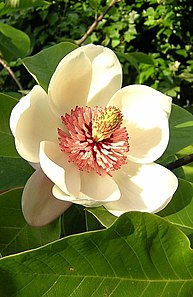
The Magnoliales comprise an order of flowering plants.
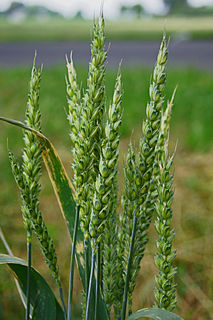
The Poales are a large order of flowering plants in the monocotyledons, and includes families of plants such as the grasses, bromeliads, and sedges. Sixteen plant families are currently recognized by botanists to be part of Poales.

The Solanales are an order of flowering plants, included in the asterid group of dicotyledons. Some older sources used the name Polemoniales for this order.
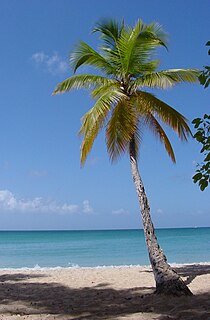
The Arecaceae are a botanical family of perennial plants. Their growth form can be climbers, shrubs, trees and stemless plants, all commonly known as palms. Those having a tree form are colloquially called palm trees. They are flowering plants, a family in the monocot order Arecales. Currently 181 genera with around 2600 species are known, most of them restricted to tropical and subtropical climates. Most palms are distinguished by their large, compound, evergreen leaves, known as fronds, arranged at the top of an unbranched stem. However, palms exhibit an enormous diversity in physical characteristics and inhabit nearly every type of habitat within their range, from rainforests to deserts.
Family is one of the eight major hierarchical taxonomic ranks in Linnaean taxonomy; it is classified between order and genus. A family may be divided into subfamilies, which are intermediate ranks between the ranks of family and genus. The official family names are Latin in origin; however, popular names are often used: for example, walnut trees and hickory trees belong to the family Juglandaceae, but that family is commonly referred to as being the "walnut family".

In biology, a taxon is a group of one or more populations of an organism or organisms seen by taxonomists to form a unit. Although neither is required, a taxon is usually known by a particular name and given a particular ranking, especially if and when it is accepted or becomes established. It is not uncommon, however, for taxonomists to remain at odds over what belongs to a taxon and the criteria used for inclusion. If a taxon is given a formal scientific name, its use is then governed by one of the nomenclature codes specifying which scientific name is correct for a particular grouping.

Piperales is a botanical name for an order of flowering plants. It necessarily includes the family Piperaceae but otherwise has been treated variously over time. Well-known plants which may be included in this order include black pepper, kava, lizard's tail, birthwort, and wild ginger.

Proteales is the botanical name of an order of flowering plants consisting of two families. The Proteales have been recognized by almost all taxonomists.
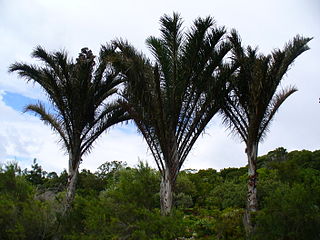
Raffia palms (Raphia) are a genus of about twenty species of palms native to tropical regions of Africa, and especially Madagascar, with one species also occurring in Central and South America. R. taedigera is the source of raffia fibers, which are the veins of the leaves, and this species produces a fruit called "brazilia pods", "uxi nuts" or "uxi pods".

Asphodelaceae is a family of flowering plants in the order Asparagales. Such a family has been recognized by most taxonomists, but the circumscription has varied widely. In its current circumscription in the APG IV system, it includes about 40 genera and 900 known species.

Phoenix canariensis is a species of flowering plant in the palm family Arecaceae, native to the Canary Islands. It is a relative of Phoenix dactylifera, the true date palm. It is the natural symbol of the Canary Islands, together with the canary Serinus canaria. Mature P. canariensis are often used in ornamental landscaping and are collected and transplanted to their new planting location. A Canary Island Date Palm with 10 m (30 ft) of trunk is approximately 60 years of age.

In plant taxonomy, commelinids is a name used by the APG IV system for a clade within the monocots, which in its turn is a clade within the angiosperms. The commelinids are the only clade that the APG has informally named within the monocots. The remaining monocots are a paraphyletic unit. Also known as the commelinid monocots it forms one of three groupings within the monocots, and the final branch, the other two groups being the alismatid monocots and the lilioid monocots.
Karl Ewald Maximilian Burret, commonly known as Max Burret was a German botanist.
Gloria Amparo Galeano Garcés was a Colombian botanist and agronomist specializing in the palm family. Galeano was a faculty member at the National University of Colombia, and was the director of at the Institute of Natural Sciences from 2003 to 2006. She received her Ph.D. from the University of Aarhus, Denmark in 1997.
Andrew James Henderson is a palm-systematist and Curator of the Institute of Systematic Botany at the New York Botanical Garden. He has authored taxonomic descriptions of 140 species, subspecies and varieties of plants, especially in the palm family
Harold Emery Moore, Jr. was an American botanist especially known for his work on the systematics of the palm family. He served as Director of the L. H. Bailey Hortorium at Cornell University, and was appointed Liberty Hyde Bailey Professor of Botany in 1978. He was an important contributor to Hortus Third and was founding editor of the palm journal Principes. He also edited Gentes Herbarum and provided the foundation for the first edition of Genera Palmarum, a seminal work on palm taxonomy which was later completed by Natalie Uhl and John Dransfield.
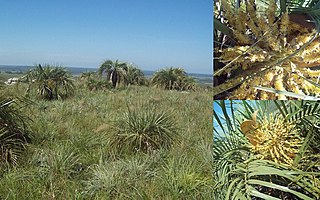
Butia paraguayensis is a species of Butia palm tree found in the cerrado region of South America. Its natural range runs from Mato Grosso do Sul and São Paulo in southern Brazil through Paraguay to northern Argentina and Uruguay. It was given the name dwarf yatay palm in English by 2000, and it is locally known as yata'i in Guaraní in Paraguay, or butiá-do-cerrado in Portuguese in Rio Grande do Sul, Brazil.
Natalie Whitford Uhl (1919–2017) was an American botanist who specialised in palms.













